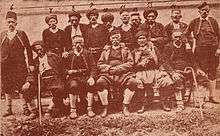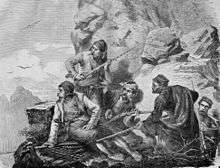Herzegovina Uprising (1875–77)
| Herzegovina Uprising 1875–77 | |||||||
|---|---|---|---|---|---|---|---|
| Part of Rise of nationalism under the Ottoman Empire | |||||||
 An illustrated depiction of Bogdan Zimonjić, Mićo Ljubibratić, Stojan Kovačević, and Pecija in the 1876 issue of Orao, a Serb annual magazine published in Novi Sad. | |||||||
| |||||||
| Belligerents | |||||||
|
| ||||||
| Commanders and leaders | |||||||
|
| ||||||
| Strength | |||||||
| 50,000+ [2] | Unknown | ||||||
| Casualties and losses | |||||||
| Unknown | Unknown | ||||||
The Herzegovina Uprising of 1875–77 (Serbo-Croatian: Hercegovački ustanak, Serbian Cyrillic: Херцеговачки устанак) was an uprising led by ethnic Serbs against the Ottoman Empire, firstly and predominantly in Herzegovina (hence its name), from where it spread into Bosnia. It is the most significant of the rebellions against Ottoman rule in Herzegovina. The uprising was precipitated by the harsh treatment under the beys and aghas of the Ottoman province (vilayet) of Bosnia — the reforms announced by the Turkish Sultan Abdülmecid I, involving new rights for Christian subjects, a new basis for army conscription, and an end to the much-hated system of tax-farming, were either resisted or ignored by the powerful Bosniak landowners. They frequently resorted to more repressive measures against their Christian subjects. The tax burden on Christian peasants constantly increased.[3]
The rebels were aided with weapons and volunteers from the Principalities of Montenegro and Serbia, whose governments eventually jointly declared war on the Ottomans on 18 June 1876, leading to the Serbo-Turkish War (1876–78) and Montenegrin–Ottoman War (1876–78), which in turn led to the Russo-Turkish War (1877–78) and Great Eastern Crisis. A result of the uprisings and wars was the Berlin Congress in 1878, which gave Montenegro and Serbia independence and more territory, while Austro-Hungary occupied Bosnia and Herzegovina for 30 years, although it remained de jure Ottoman territory.
Background
- History of Bosnia and Herzegovina (1463–1878), Bosnia Eyalet, Herzegovina Eyalet
- Serbian Revolution
- 19th century events in Bosnia and Herzegovina
Preparations
In Herzegovina
The leaders of the people of Herzegovina: Jovan Gutić, Simun Zečević, Ilija Stevanović, Trivko Grubačić, Prodan Rupar and Petar Radović, at the end of August and beginning of September 1874, met and decided to start preparing a rebellion. They conclude with preparing weapons and ammunition, safe-places for people, assistance of Montenegro in the uprising, concluding that the uprising is to break out in Spring 1875. The group entered in talks with Nikola I Petrović, but he was not willing to break and risk the unreadiness of Russia in its war with the Ottomans. The preparations continued, and in Bileća and Trebinje region, serdar Todor Mujičić, Gligor Milićević, Vasilj Svorcan and Sava Jakšić lead the revolt in these regions.
The Ottomans hear of the talks between Nikola I and tries to capture the ringleaders, they however flee into Montenegro in the winter of 1874. In 1875, Austria is drawn in, and with its interests in Bosnia and Herzegovina, they ask the Ottomans to give the ringleaders amnesty. The pressured Ottomans join in discussion with Austria.
In Bosnia
The preparations start somewhat later than the Herzegovinian and did not manage to coordinate actions of the two regions. In the preparations are Vaso Vidović, Simo and Jovo Bilbija, Spasoje Babić and Vaso Pelagić. The plans began with firstly liberating the villages of Kozara; Prosara and Motajica, then attack communications and block the cities of the Sava river, later to take over Banja Luka. The start of the uprising was envisaged on August 18, 1875. The Ottomans imprisoned priests in Prijedor, which put further pressure on the people, therefore villagers from Dvorište, Čitluka, Petrinje, Bačvani, Pobrđani and Tavija attack the Turks in Dvorište on August 15. The uprising sparks wide, and the leader of the uprising is chosen to be Ostoja Kormanoš.
Uprising in Herzegovina
Nevesinje


The leaders return in 1875 and continue their plans on revolt, the plan seeks liberation of Nevesinje region, then expansion on the rest of Herzegovina. In the meantime, Turks seek hajduk Pera Tunguz, who on July 5, had attacked a caravan on the Bišini mountain. On July 9, the Turks start a conflict with the armed villagers of Jovan Gutić on the Gradac hill north of Krekova. This conflict would be known as Nevesinjska puška ("Nevesinje gun") and marked the beginning of the uprising in all of Herzegovina. Firstly Nevesinje, Bileća and Stolac were involved, then in August, Gacko and the frontier towards Montenegro. Četa (bands) of 50–300 people and bands of 500–2,000 people gather and attack Ottoman border posts and bey towers.

The Ottomans had 4 battalions of regular army (nizami) with a total of 1,800 soldiers, situated in Mostar, Trebinje, Nikšić, Foča and the border posts, also a larger number of başıbozuk are present all over the province. The Ottoman troops are commanded by Selim Pasha (Selim-paša) who in turn is under Dervish Pasha (Derviš-paša), the commander of the Bosnia Vilayet. After the outbreak of the uprising, the Turks try to gain time by starting negotiations while reinforcements arrive. The rebels wanted lower taxes, which the Turks refused, and the fighting continues. In August, 4000 nizami arrive from Bosnia, and later 4 more battalions by sea through Klek in Trebinje. The rebels had by July and August destroyed the majority of border posts and besieged Trebinje in August 5. The Turks regained Trebinje by August 30. In the end of August, fights break out in Bosnia, and Serbia and Montenegro promise aid, sparking an intensification of the uprising.

Prince Nikola sent Petar Vukotić, while a large number of Montenegrin volunteers arrived at the command of Peko Pavlović. The Serbian government dared not to publicly assist because of international pressure, but secretly sent Mićo Ljubibratić (who took part in the 1852–1862 uprising) among others. There was a conflict between the rebels because of disagreement between the representatives of the Montenegrin and Serbian governments, causing failures in the ongoing uprising.

Uprising in Bosnia
According to Herr Fric, the Serbian rebels were "extremely numerous, and in some cases well armed" and were divided among following troops and bands:[4]
- The troops were under the leadership of well known Golub Babić, Marinković, Simo Davidović, Pope Karan, and Trifko Amelić. The Serb colonel Despotović held supreme leadership and had formed 8 battalions out of the scattered bands.[4]
- The bands were led by Marko Djenadija, Ostoja, Spasojević, Marko Bajalica, Igumen Hadzić, and Pope Stevo. The new camp of Brezovac, not far from Novi, was held by Ostoja Vojnović. The former camp of Karađorđevići in Ćorkovac was held by Ilija Sević.[4]
The aim of the bands was to prevent any greater concentration of Turkish troops on the Drina, on the western frontier of Serbia. As a systemically organized insurrection in Bosnia is of no possibility, the rebels pursue and drive back the Muslim population into their towns. The bands protect and help the exiles hiding in the woods; unarmed men, women, and children, to reach the frontier of Austria or Serbia through safe conduct.[5]
According to Mackenzie and Irby who traveled the region in 1877, the state of the common Christian people was serious, and the number of fugitives exceeded 200,000 all round the frontier by January 1877.[6]
The rebels in South Bosnia had cleared the region of Turks, presently under the command of Despotović, between the Austrian frontier and the Turkish fortresses of Kulin Vakup, Ključ, and Glamoč.[7]
In August 1877, all Bosnian Muslims men from 15 to 70 were ordered to fight, although there was already 54 battalions, each with 400–700 men.[8]
- Battle of Sedlo
Aftermath
| Rise of nationalism in the Balkans Nationalism under the Ottoman Empire |
|---|

The unrest rapidly spread among the Christian populations of the other Ottoman provinces in the Balkans (notably the April Uprising in Bulgaria) setting off what would become known as the Great Eastern Crisis. The atrocities of the Ottoman Empire in suppressing unrest in the Balkan provinces eventually led to the Russo-Turkish War of 1877–78, which ended in Turkish defeat, and the signing of the Treaty of San Stefano in March 1878, followed in July of the same year by the Treaty of Berlin, severely reducing Ottoman territories and power in Europe. The Congress of Berlin decided that Bosnia and Herzegovina, while remaining nominally under Turkish sovereignty, would be governed by Austria-Hungary. Austria-Hungary annexed Bosnia and Herzegovina in 1908. The occupation and annexation enraged Serbian nationalists and was a catalyst for the assassination of Archduke Franz Ferdinand of Austria by the Bosnian Serb nationalist Gavrilo Princip.
Legacy
The Nevesinje municipality has a coat of arms with two rifles, symbolizing the revolt. The government of Republika Srpska together with the Nevesinje municipality annually organizes the anniversary of the revolt.[9]
In 1963, a Yugoslav film by Žika Mitrović about the Nevesinje rebellion was released, titled in Serbo-Croatian as Nevesinjska puška and in English as Thundering Mountains.[10]
Jovan Bratić (born 1974), a comic artist from Nevesinje, made a cartoon series on the Herzegovina Uprising, titled Nevesinjska puška, the first part released in 2008,[11] and the second part Nevesinjska puška 2: Bitka na Vučjem dolu.[12]
See also
| Wikimedia Commons has media related to Herzegovina Uprising (1875–77). |
| History of Herzegovina |
|---|
|
References
- ↑ Jelena Džank , Citizenship in Bosnia and Herzegovina,
- ↑ Castellan, Georges,
- ↑ "Bosnia and Herzegovina", Encyclopædia Britannica (online ed.), June 29, 2007.
- 1 2 3 4 5 6 Travels in the Slavonic Provinces of Turkey-In-Europe, p. 42
- ↑ Travels in the Slavonic Provinces of Turkey-In-Europe,p. 43
- ↑ Travels in the Slavonic Provinces of Turkey-In-Europe, p. 47.
- ↑ Travels in the Slavonic Provinces of Turkey-In-Europe, p. 50
- ↑ Panslavism and national identity in Russia and in the Balkans, 1830–1880, p. 146, Google Book.
- ↑ http://www.atvbl.com/obiljezeno-137-godina-od-ustanka-nevesinjska-puska/. Missing or empty
|title=(help) - ↑ "Thundering Mountains (1963)".
- ↑ http://mojahercegovina.com/u-prodaji-je-drugo-objedinjeno-izdanje-stripa-nevesinjska-puska/. Missing or empty
|title=(help) - ↑ http://mojahercegovina.com/intervju-sa-jovanom-braticem-strip-autorom-iz-nevesinja/. Missing or empty
|title=(help)
Sources
- Milorad Ekmecic, Ustanak u Bosni 1875–1878 [Bosnian Uprising 1875–1878], (Sarajevo, 1973).
- G Muir MacKenzie, Adelina P Irby, Travels in the Slavonic Provinces of Turkey-In-Europe (Vols. I and II)
- Arthur Evans, J. Sir., Sir Arthur J Evans, Illyrian Letters: A Revised Selection of Correspondence from the Illyrian Provinces of Bosnia, Herzegovina, Montenegro, Albania, Dalmatia, Croatia, and Slavonia, 1877, Google Book, ISBN 1-60206-339-7, ISBN 978-1-60206-339-6
- Vojna Enciklopedija, Beograd, 1970., knjiga prva, strane 756 do 759.
- У организацији Одбора за његовање традиција ослободилачких ратова Владе Републике Српске: Обиљежена 134. годишњица Невесињске пушке (Serbian)
Further reading
- Ković Miloš (2010). "The beginning of the 1875 Serbian uprising in Herzegovina the British perspective". Balcanica. 41: 55–71.
